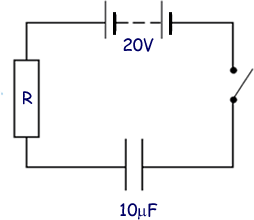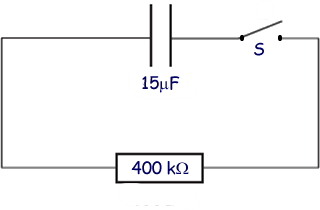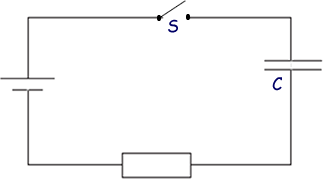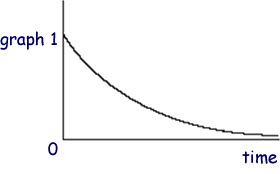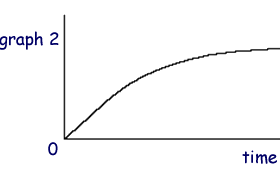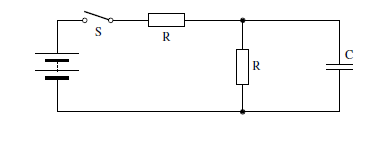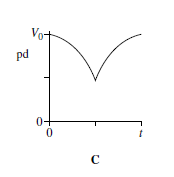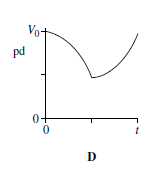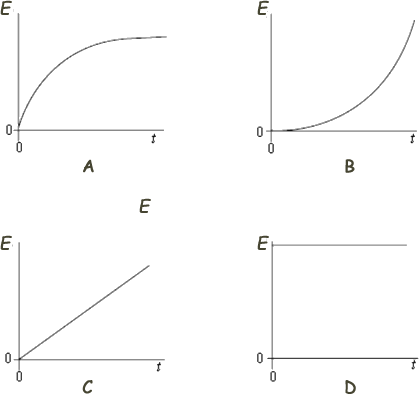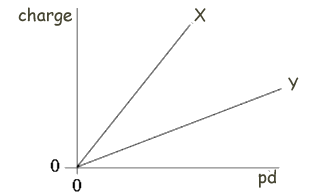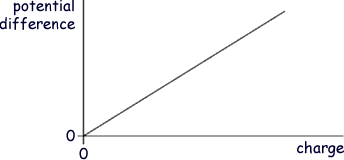 Q1. A 1μF capacitor is charged using a constant current of 10 μA for 20 s. What is the energy finally stored by the capacitor? E = ½ Q V = ½ C V2 = ½ Q2/ C Q = It E = ½ (It)2/C E = ½ (10 x 10-6 x 20)2/10-6 E = 0.02 J (Choice B)
Q2. A capacitor of capacitance 10 μF is fully charged through a resistor R to a p.d. of 20V using the circuit shown below.
Which one of the following statements is incorrect?
Q3. A 10 mF capacitor is charged to 10V and then discharged completely through a small motor. During this process, the motor lifts a weight of mass 0.10 kg. If 10 % of the energy stored in the capacitor is used to lift the weight, through what approximate height will the weight be lifted? The energy stored in the capacitor is used to power the motor… well 10% of it anyway! So, as E = ½ Q V = ½ C V2 = ½ Q2/ C 10% of E = 0.10 x ½ 10 x 10-3 x 102 = 0.05 J work done = mg=Δh 0.05 = 0.10 x 9.81 x Δh Δh = 0.05m
Q4. A capacitor of capacitance 15 μF is fully charged and the potential difference across its plates is 8.0V. It is then connected into the circuit as shown below.
The switch S is closed at time t = 0. Which one of the following statements is correct?
Q5. A capacitor of capacitance C discharges through a resistor of resistance R. Which one of the following statements is not true?
Q6. In the circuit shown below, the capacitor C is charged to a potential difference V when the switch S is closed.
Q7. The graph shows how the charge stored by a capacitor varies with the potential difference across it as it is charged from a 6V battery.
Which one of the following statements is not correct?
Q8. A capacitor of capacitance C stores an amount of energy E when the pd across it is V. Which line, A to D, gives the correct stored energy and pd when the charge is increased by 50% ?
p.d. is proportional to Q If charge is increased by a half that is a factor of 1.5 that V will increase by E = ½ QV = ½ CV2 = ½ Q2/C E is proportional to Q2 If charge is increased by a half that is a factor of 1.5 so energy will increase by 1.52 = 2.25
Q9. How many of the following four equations correctly represent the energy E stored by a capacitor of capacitance C when it is charged to a pd V and its charge is Q?
E = ½ QV = ½ CV2 = ½ Q2/C
Q10. A voltage sensor and a datalogger are used to record the discharge of a 10 mF capacitor in series with a 500Ω resistor from an initial pd of 6.0V. The datalogger is capable of recording 1000 readings in 10s.
Which line, A to D, in the table gives the pd and the number of readings made after a time equal to the time constant of the discharge circuit? Time constant = CR = 10 x 10-3 x 500 = 5s Datalogger gives 100 readings per second Therefore in 5s it will give 500 readings. ----------------------- V = V0e-t/RC V = V0e-1 V = 6.0 x 0.368 = 2.2 volts
Q11. When switch S in the circuit is closed, the capacitor C is charged by the battery to a pd V0.
Which graph best shows how the pd across the capacitor varies with time, t, after S is opened?
Choice A - the capacitor is fully charged at time t=0... it then discharges. Discharge is exponential... therefore A or B fit the bill. On recharge, pd will increase exponentially (most rapidly at first), therefore it must be A.
How long can the
capacitor be used for before it must be recharged?
Q13. When a capacitor discharges through a resistor it loses 50% of its charge in 10 s. What is the time constant of the capacitor-resistor circuit?
Q14. An uncharged capacitor of fixed capacitance is connected in series with a switch and battery. The switch is closed at time t = 0. Which graph, A to D, shows how the energy, E, stored by the capacitor, changes with time, t, after the switch is closed?
Energy stored = ½ QV = ½ CV2 = ½ Q2/C The voltage across the capacitor will be the same as graph A - the energy stored will therefore be that graphline value squared - which will be a similar shape - choice A Choice D is not possible as energy stored will increase and be zero at time zero. Choice C is a steady increase with time and we know that voltage increase is rapid at first. Choice B is not possible because the voltage increase and therefore the energy stored will level off towards completion of the charge.
Q15.The voltage across a capacitor falls from 10 V to 5 V in 48 ms as it discharges through a resistor. What is the time constant of the circuit?
V = V0e-t/RC 5 = 10 e-0. 48/RC ln 0.5 = -0.048/RC RC = - 0.048 /ln 0.5 RC = 0.069s = 69ms Q16. The graph shows how the charge stored by each of two capacitors, X and Y, increases as the pd across them increases. Which one of the following statements is correct?
Q = CV Therefore as V increases Q will increase C is constant - the gradient of the graph. X has a bigger gradient so the capacitance of X is greater than the capacitance of Y. Q17. A 1000 μF capacitor and a 10 μF capacitor are charged so that the potential difference across each of them is the same. The charge stored in the 1000 μF capacitor is Q1 and the charge stored in the 10 μF capacitor is Q2. What is the ratio Q1/Q2?
Q = CV V = Q/C Therefore Q1/C1 = Q2/C2 Q1/Q2= C1 /C2 = 1000/10 = 100 - Choice A Or you can just reason it - capacitor 1 has 100 times the capacitance of capacitor 2 - therefore it will store 100 times more charge as it has a 100x capacity for charge! Q18. The graph shows how the potential difference across a capacitor varies with the charge stored by it.
Which one of the following statements is correct? Q = CV therefore V = Q/C V = 1/C x Q this corresponds to y = mx The gradient is therefore 1/C Energy stored is the area under the graph line not the gradient.
Q19. An initially uncharged capacitor of capacitance 10 μF is charged by a constant current of 200 μA. After what time will the potential difference across the capacitor be 2000V? Q = CV Q = 10 x 10-6 x 2000 = 0.020 coulombs I = Q/t t = Q/I = 0.020/(200 x 10-6) = 100 s
Q20. A 1000 μF capacitor, X, and a 100 μF capacitor, Y, are charged to the same potential difference. Which row, A to D, in the table gives correct ratios of charge stored and energy stored by the capacitors? Charge stored = CV = 1000μ/100μ = 10 ------------------------- Energy stored = ½ QV = ½ CV2 = ½ Q2/C V is constant so energy stored depends on C ratio will be 1000μ/100μ = 10
|
Follow me...
|


